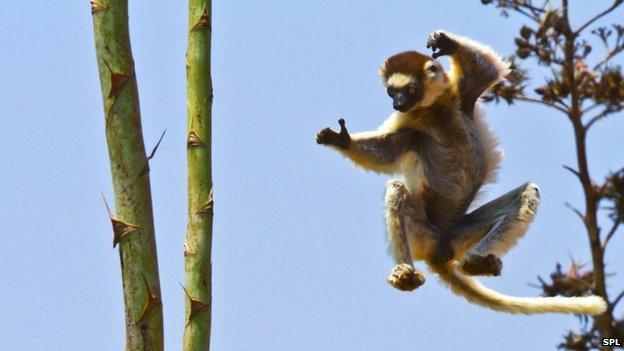Tourism best hope for critically endangered lemurs
- Published

Madagascar's lemurs - the world's most threatened primate - could be saved from extinction by eco-tourism, conservationists say.
The big-eyed fluffy creatures are unique to the island but their numbers have declined dramatically in recent years.
Now researchers have unveiled a survival plan that combines tourism with increased conservation efforts.
Writing in Science, external, the team says the project will cost £4.6m ($7.6m),
There are over 100 species of lemur known to science, the majority of which are at dangerously low levels, largely due to habitat loss from illegal logging.
Madagascar is the only known home of these species as its unique location, split off from the African mainland, has allowed the primates to evolve in near isolation.

Political turmoil has enveloped Madagascar following a coup in 2009. As a result of the instability, illegal logging has increased on the island, a source of valuable rosewood and ebony trees.
Due to a lack of environmental policing, the habitat of the lemurs has been under constant threat and the primates are now one of the most endangered groups of vertebrates on the planet.
Over 90% of these species are at risk and are on the International Union for the Conservation of Nature's (IUCN)'s red list of threatened species.
This includes over 20 species regarded as critically endangered, which is the highest level of threat.
The team propose that cashing in on Madagascar's unique lemur "brand" would help the animals and poor rural communities.
Dr Christoph Schwitzer from the Bristol Zoological Society has been working in Madagascar for more than a decade. He said that tourists had still been flocking to the island, despite the political instability.
"There's always a trade-off between the destruction caused by too many tourists and the money they bring to the country that can be used for wildlife conservation," he told the BBC's Science in Action programme.
"This balance for Madagascar is still very positive for conservation and it's a long way until it may tip over."
Conservationists point to eco-tourism in Rwanda and Uganda where visitors are willing to pay a premium to observe endangered mountain gorillas in their natural habitat.
There are already successful examples of this in Madagascar such as the Maromizaha forest which is home to at least 13 lemur species.
Local villagers have been taught English and French and several now work as guides. A multi-purpose interpretive centre has also been built there.
While just eight visitors came to the forest in 2008, by 2011 this had increased to 208.
"Obviously these people spend money in local communities and contribute to the upkeep, maintenance and management of protected areas," added Dr Schwitzer.
Other aspects of a new three-year emergency action plan include increasing the number of long-term research field stations and building up conservation programmes.
These could help reduce another threat to lemurs, the illegal hunting of the primates for bushmeat.

Dr Schwitzer and colleagues have been in charge of a field station for the past decade and they found that this station deterred illegal activity on protected areas nearby.
This would also help stop illegal logging for tropical hardwood which destroys the lemurs' natural habitats - a key issue threatening their survival.
Despite the challenges, Dr Schwitzer said he was hopeful they could "scrape together the funding". He pointed out that the money was small in terms of international aid and could bring a significant return in preserving a unique habitat.
"We haven't lost a single species of lemur - indeed not a single species of primate, during the last two centuries since our records began.
"We have the people, we have the place, we have the ideas, we are just just lacking funding," he added.
Listen to Science in Action on the BBC World Service at 20:30 GMT or download the podcast here
- Published13 July 2012
- Published15 December 2011
- Published5 August 2010